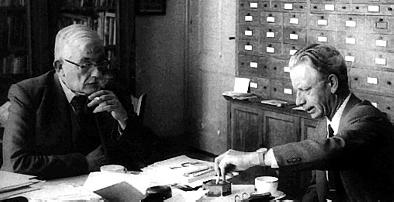<Back to Index>
- Microbiologist Cornelis Bernardus "Kees" van Niel, 1897
PAGE SPONSOR

Cornelis Bernardus (Kees) van Niel (November 4, 1897, Haarlem – March 10, 1985, Carmel, California) was a Dutch - American microbiologist. He introduced the study of general microbiology to the United States and made key discoveries explaining the chemistry of photosynthesis.
In 1923, Cornelis van Niel married Christina van Hemert, graduated in chemical engineering at Delft University and became an assistant to Albert Jan Kluyver, who had initiated the field of comparative biochemistry. In 1928 he wrote his PhD dissertation ('The Propionic Acid Bacteria') after which he left for the United States to continue his work at the Hopkins Marine Station of Stanford University.
By studying purple sulfur bacteria and green sulfur bacteria he was the first scientist to demonstrate that photosynthesis is a light - dependent redox reaction, in which hydrogen from an oxidizable compound reduces carbon dioxide to cellular materials. Expressed as:
- 2 H2A + CO2 → 2A + CH2O + H2O
His discovery predicted that H2O is the hydrogen donor in green plant photosynthesis and is oxidized to O2. The chemical summation of photosynthesis was a milestone in the understanding of the chemistry of photosynthesis. This was later shown to be by Robert Hill.
Esther Lederberg was one of C.B. van Niel's accomplished students, as was Allan Campbell.
In 1961, Van Niel in collaboration with R.Y. Stanier defined prokaryotes as cells in which the nuclear material is not surrounded by a nuclear membrane, a definition that is still used to date. He received the American National Medal of Science in 1963.